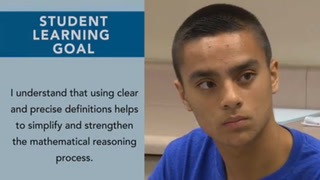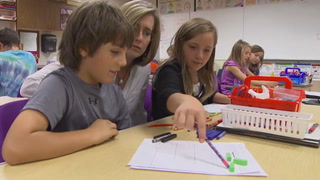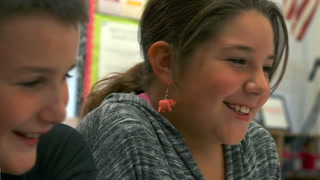Series Formative Assessment Practices to Support Student Learning: Formative Assessment: Understanding Fractions
Math.Practice.MP1
| Common core State Standards
- Math: Math
- Practice: Mathematical Practice Standards
-
MP1: Make sense of problems and persevere in solving them.
Mathematically proficient students start by explaining to themselves the meaning of a problem and looking for entry points to its solution. They analyze givens, constraints, relationships, and goals. They make conjectures about the form and meaning of the solution and plan a solution pathway rather than simply jumping into a solution attempt. They consider analogous problems, and try special cases and simpler forms of the original problem in order to gain insight into its solution. They monitor and evaluate their progress and change course if necessary. Older students might, depending on the context of the problem, transform algebraic expressions or change the viewing window on their graphing calculator to get the information they need. Mathematically proficient students can explain correspondences between equations, verbal descriptions, tables, and graphs or draw diagrams of important features and relationships, graph data, and search for regularity or trends. Younger students might rely on using concrete objects or pictures to help conceptualize and solve a problem. Mathematically proficient students check their answers to problems using a different method, and they continually ask themselves, \"Does this make sense?\" They can understand the approaches of others to solving complex problems and identify correspondences between different approaches.
Math.Practice.MP2
| Common core State Standards
- Math: Math
- Practice: Mathematical Practice Standards
-
MP2: Reason abstractly and quantitatively.
Mathematically proficient students make sense of quantities and their relationships in problem situations. They bring two complementary abilities to bear on problems involving quantitative relationships: the ability to decontextualize--to abstract a given situation and represent it symbolically and manipulate the representing symbols as if they have a life of their own, without necessarily attending to their referents—and the ability to contextualize, to pause as needed during the manipulation process in order to probe into the referents for the symbols involved. Quantitative reasoning entails habits of creating a coherent representation of the problem at hand; considering the units involved; attending to the meaning of quantities, not just how to compute them; and knowing and flexibly using different properties of operations and objects.
Math.3.NF.A.1
Common core State Standards
- Math: Math
- 3: Grade 3
- NF: Numbers & Operations--Fractions
- A: Develop understanding of fractions as numbers
-
1:
Understand a fraction 1/b as the quantity formed by 1 part when a whole is partitioned into b equal parts; understand a fraction a/b as the quantity formed by a parts of size 1/b.
Grade 3 expectations in this domain are limited to fractions with denominators 2, 3, 4, 6, 8.
Save to My Resources
PLEASE CREATE A NEW ACCOUNT OR LOG IN TO ACCESS THIS CONTENT
Enjoy your first video for free. Subscribe for unlimited access.
Have questions about subscribing?
Click Here to learn more about individual subscriptions.
Click Here to learn more about School and Institution access.
Discussion and Supporting Materials
Thought starters
- Why does Ms. Romano decide to assess her fourth graders' understanding of a third grade content standard?
- How does Ms. Romano encourage productive struggle during the lesson?
- What instructional decisions does Ms. Romano make based on her observations during the collaborative work?
School Details
Four Georgians School555 West Custer Avenue
Helena MT 59602
Population: 485
Data Provided By:

Teachers
Melissa Romano
Newest
|
4 MIN
|
5 MIN
|
5 MIN
UNCUT CLASSROOMS
| TCHERS' VOICE
English Language Arts












109 Comments
Carl DeShay Apr 18, 2024 10:17pm
1. Why does Ms. Romano decide to assess her fourth graders' understanding of a third grade content standard?
Ms. Romano suspects her students haven't fully grasped a concept from third grade that's foundational for the current fourth-grade material. This assessment helps her identify any learning gaps that need to be addressed before moving forward.
2. How does Ms. Romano encourage productive struggle during the lesson?
Productive struggle is when students grapple with a problem or concept, leading to deeper learning. By having the students work together allows them to learn from each other's explanations, leading to a deeper understanding of the concept.
3. What instructional decisions does Ms. Romano make based on her observation during the collaborative.
In observing her students during the formative assessment, Ms. Romano gained valuable insights into their understanding and this gives her an informed decision about how to move forward in her instruction.
Michael Daigre Sep 9, 2023 10:30pm
I believe Mrs. Romano wanted to assess her students understanding of a third grade standard to better understand where each student was. This allowed the teacher to assess the foundation before moving forward with the next topic area. While watching the video she also explained the purpose of productive struggle. She wants to make sure the student has time to think, discuss, analyze, and use previous teaching points to answer their own questions. Mrs. Romano and the students both feel, if she provides the answers right away the students may not have clear understanding of a specific topic.
Once the class continued to work through the fraction worksheet, Mrs. Romano noticed several students having trouble with a specific question. She felt it was best to work this problem together as a class and allow an open discussion because the question was more complex. She also reflected on areas within her lesson where she could make improvements to increase the understanding of the complex fraction question.
Gregory Broussard Sep 5, 2023 9:42am
1. Ms Romano assessed her students' knowledge of third grade content standards in order to frame her questions and strategies connecting what they already know to what she is presenting in the lesson.
2. Ms Romano encourages productive struggle in order to know that the students understand the lesson and can explain their answers. She wants to provide an environment and opportunity for them to think and solve problems individually and in groups. She does not want to help them without giving them the opportunity to form their own thoughts.
3. Ms. Romano's instructional decisions are based on evidence she gathers while interacting with her students. The evidence helps her to change instruction, questions, strategies, etc.
Nakeisha Gardner Aug 9, 2023 8:25am